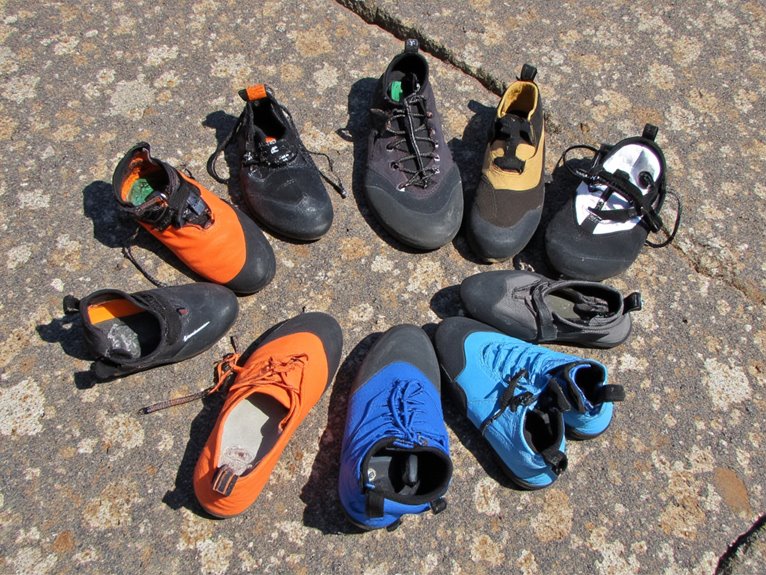What Is the Difference Between B1 and B2 Crampons?
The Union of International Alpine Associations (UIAA) categorizes crampons into three main types, with B1 and B2 being the most popular. B1 crampons are designed for general mountaineering and glacier travel, featuring a hybrid design that balances flexibility and stability. They are suitable for snow and ice slopes up to 30-40 degrees and are compatible with hiking boots or insulated mountaineering boots. B2 crampons, on the other hand, prioritize weight reduction and durability for superior performance in demanding alpine environments, making them ideal for rugged terrain and high-altitude climbing. To select the right crampon type for your adventure, it's essential to understand the specific demands of your climbing objective; there's more to bear in mind when choosing the perfect fit.
We are supported by our audience. When you purchase through links on our site, we may earn an affiliate commission, at no extra cost for you. Learn more. Last update on 15th January 2026 / Images from Amazon Product Advertising API.
Crampon Classification and Ratings
Crampons are classified into different categories based on their intended use, with the Union of International Alpine Associations (UIAA) providing a rating system that defines the capabilities and limitations of each type.
This rating system guarantees that climbers and mountaineers select the appropriate crampons for their specific needs.
The UIAA categorizes crampons into three main types: B1, B2, and B3, each with distinct features and applications.
B1 crampons are designed for general mountaineering and glacier travel, while B2 crampons are suited for more technical and demanding terrain.
Understanding the UIAA rating system and crampon classification is vital for safe and effective use in various mountain environments.
B1 Crampons: Features and Uses
Mountaineers and climbers seeking versatile and adaptable gear for general glacier travel and moderate snow and ice terrain often turn to B1 crampons, which offer a balance of functionality and lightweight design.
B1 crampons are designed for general mountaineering, glacier travel, and moderate snow and ice climbing. They typically feature a hybrid or semi-rigid design, providing a balance between flexibility and stability.
They are also often lighter and more compact than B2 crampons, making them ideal for backpackers and climbers who need to travel long distances.
B1 crampons are suitable for snow and ice slopes up to 30-40 degrees and are compatible with hiking boots or insulated mountaineering boots.
B2 Crampons: Key Characteristics
B2 crampons are engineered to provide superior performance in demanding alpine environments.
Their design prioritizes weight reduction and durability to guarantee reliable traction and grip on varied snow and ice surfaces.
Key features of B2 crampons include optimized weight distribution, aggressive traction points, and adjustable components that facilitate a secure and customizable fit.
Weight and Durability
Built for rugged terrain, B2 crampons are engineered to withstand the harsh conditions of glacier travel and high-altitude climbing, boasting a robust construction that prioritizes durability over minimalism.
This emphasis on durability translates to a slightly heavier design, with B2 crampons often weighing between 3-4 pounds per pair.
While this added weight may be a drawback for some, it's a necessary trade-off for the reliability and strength required in extreme alpine environments.
The durability of B2 crampons is further reinforced by the use of high-quality materials, carefully selected to resist corrosion and withstand the rigors of heavy use.
As a result, B2 crampons are well-suited for extended expeditions and repeated use in harsh conditions.
Traction and Grip
Every step counts in high-altitude climbing, and the aggressive traction pattern of B2 crampons, featuring 12-14 points of contact, provides the essential grip and stability needed to tackle demanding terrain with confidence.
This increased surface area allows for superior grip on ice, hard snow, and rocky surfaces, enabling climbers to maintain momentum and control.
The aggressive design also helps to shed snow and ice, reducing the risk of balling and ensuring consistent performance.
The result is a more secure and efficient climbing experience, even in the most challenging conditions.
With B2 crampons, climbers can focus on the ascent, knowing their feet are securely planted on the mountain.
Adjustable Features
A hallmark of B2 crampons is their adaptability, which is facilitated by adjustable features that enable climbers to customize the fit and performance to suit their specific needs and preferences.
These adjustments allow for a more secure fit, improved stability, and augmented performance on varied terrain.
Typically, B2 crampons feature adjustable heel and toe bails that can be tailored to accommodate different boot sizes and styles.
This adaptability also extends to the crampon's overall length, which can be adjusted to suit different climbing styles and snow conditions.
Binding Systems and Compatibility
Most modern crampons feature one of two primary binding systems: step-in or strap-on, each with its own unique advantages and compatibility considerations.
Step-in bindings offer a secure and efficient attachment, but may not be compatible with all boot types.
Strap-on bindings, on the other hand, provide greater versatility and adaptability to different boot styles, but can be more time-consuming to put on and take off.
It is vital to verify compatibility between the crampons and boots to guarantee a safe and reliable connection.
Additionally, some crampons may feature hybrid bindings that combine elements of both step-in and strap-on systems.
When selecting crampons, it is vital to weigh the binding system and its compatibility with your boots to guarantee superior performance and safety.
Performance in Different Conditions
While a compatible binding system is essential, the performance of B1 and B2 crampons in various conditions, such as ice, snow, and rock, is equally vital to weigh when selecting the right pair for your needs.
B1 crampons, designed for glacier travel and general mountaineering, excel in snow and moderate ice conditions, providing a balance between traction and flexibility.
In contrast, B2 crampons, built for more demanding alpine and ice climbing, are better suited for steep, hard ice and rocky terrain, where their more aggressive front points and stiffer construction provide added stability and support.
Understanding the performance differences between B1 and B2 crampons in various conditions is vital for selecting the right tool for your specific adventure.
Choosing the Right Crampon Type
Choosing the Right Crampon Type
When selecting the right crampon type, consider the specific demands of your climbing objectives, as the correct choice between B1 and B2 crampons can substantially impact your performance and safety.
Assess the terrain, snow conditions, and your personal climbing style to determine the most suitable option.
B1 crampons are ideal for general mountaineering, glacier travel, and snowshoeing, while B2 crampons are better suited for more technical, steep, and icy terrain.
Consider factors such as weight, durability, and adjustability when making your decision.




